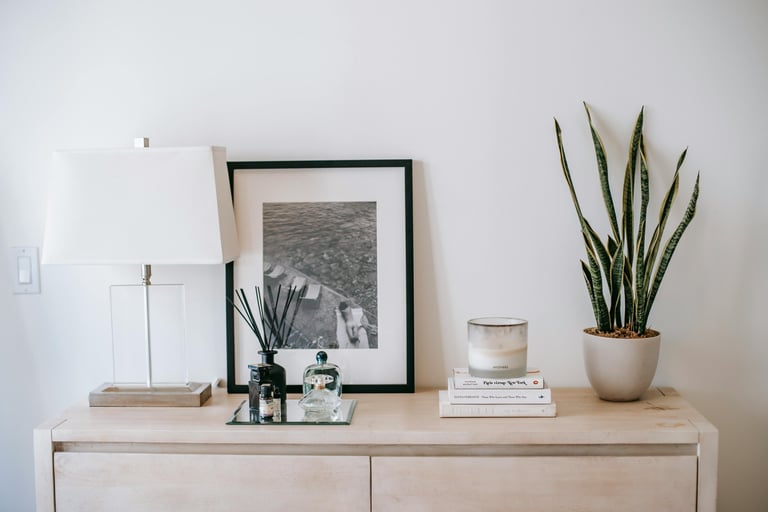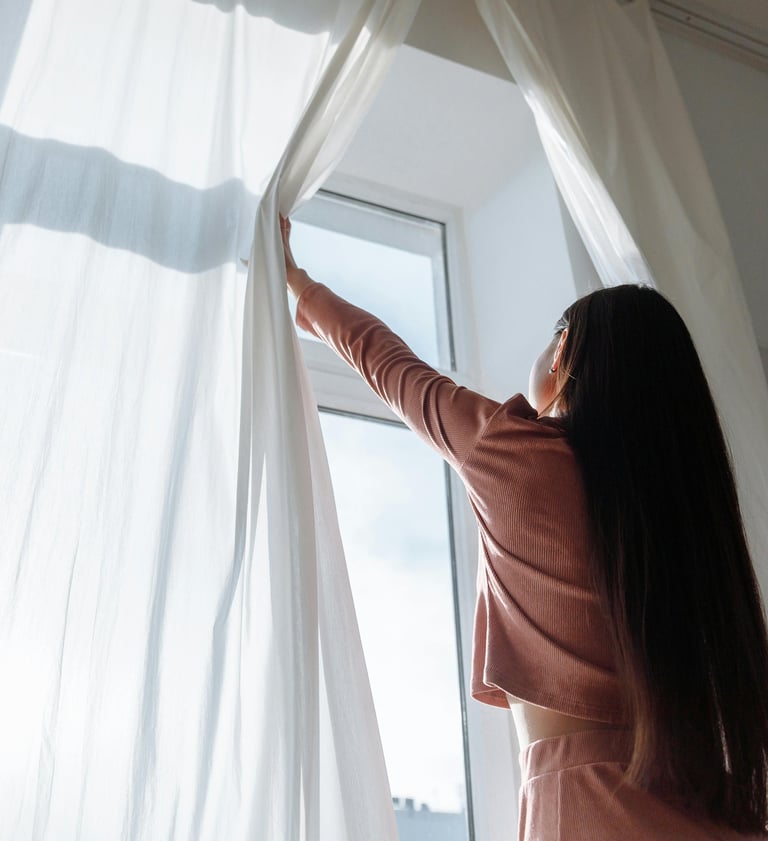5 Tips for a Cozy and Welcoming Home Atmosphere
Discover how to strategically enhance your home's spaces for improved mental health and create a more peaceful, calming environment and a welcoming home atmosphere for you and your loved ones.
3/8/202510 min read
How to Create an Uplifting Mood in Your Home and How it Impacts You
I love to decorate my home. Creating a space that makes me, my family, and guests feel at ease and comfortable is very important to me. These five tips are a great way to gain some inspiration for giving your home a little boost. And learning about why exactly these suggestions make a difference for us on a physiological level is fascinating.


*As an amazon associate, I earn commission on listed products at no extra cost to you.


Why Soothing Sounds Help
Our brains are naturally attuned to sound. Certain sounds can trigger a relaxation response, helping to lower stress and reduce anxiety. Research has shown that nature sounds, white noise, and gentle music can help regulate emotions and even improve focus and productivity. For moms, this means you can create a peaceful environment not only for yourself but also for your family.
Here's a deeper look into the neurological effects of calming music, supported by specific studies:
1. Activation of the Parasympathetic Nervous System: Calming music can stimulate the parasympathetic nervous system, leading to reduced heart rate and blood pressure, promoting relaxation.
2. Release of Neurochemicals:
Dopamine: Listening to enjoyable music triggers the brain's reward system, releasing dopamine, which induces feelings of pleasure and euphoria.
Oxytocin: Soothing music can increase oxytocin levels, enhancing feelings of trust and social bonding.
3. Reduced Cortisol Levels: Exposure to relaxing music has been shown to lower cortisol levels, the primary stress hormone, thereby reducing stress and anxiety.
4. Changes in Brainwave Activity: Music influences brainwave patterns, promoting states of relaxation and mental alertness.
5. Engagement of the Limbic System: Music activates the limbic system, the brain region responsible for processing emotions, which can enhance mood and emotional well-being.
These studies underscore the profound impact that soothing sounds and music can have on our neurological and emotional states.
1. Sounds
One simple yet powerful way to create a more peaceful atmosphere is through the use of soothing sounds. Whether it's the gentle hum of nature or soft melodies, adding calming sounds to your environment can help you stay grounded and bring a sense of tranquility to your home.
Ways to Incorporate Soothing Sounds
Nature Sounds: Bring the outdoors in by playing sounds of rain, ocean waves, or a gentle forest stream. These sounds are particularly helpful during stressful moments and can also create a calming backdrop for kids during quiet play or naptime.
Sound Machines: White noise can help mask disruptive sounds and create a consistent auditory backdrop that promotes focus and calm. These are especially useful during bedtime routines or if you’re working on a project that requires concentration.
Soft Music: Create a playlist of calming music, such as instrumental or classical pieces, and play it during daily routines like cooking or winding down in the evening.
Wind Chimes or Water Fountains: Adding elements to your home that naturally create soothing sounds can be both decorative and functional. Wind chimes can add a gentle melody to your outdoor space, while a small indoor water fountain can bring the calming sound of flowing water inside.
Guided Meditations or Sound Baths: Many apps and online resources offer guided meditations and sound baths using soothing tones and frequencies. These can be a great addition to your self-care routine, offering a chance to relax and reset.


Follow on Facebook
2. Lighting
When it comes to setting the mood in your home, lighting plays a powerful role. The right lighting can transform a room from stressful to soothing, energize a space, or create a cozy and welcoming atmosphere. The best part? You don’t need to spend a fortune to achieve these effects. With a few simple adjustments, you can create a fresh, uplifting environment that feels just right for you and your family.


How Lighting Affects Your Mood
Light impacts our emotions and overall well-being more than we might realize. By strategically changing your home’s lighting, you can create spaces that support whatever vibe you need. Lighting significantly influences our neurological functions, affecting mood, sleep patterns, and overall well-being. Here's how different lighting conditions impact us:
1. Influence on Circadian Rhythm and Melatonin Production
Natural Light Exposure: Exposure to natural light during the day helps regulate our internal body clock, known as the circadian rhythm, promoting alertness and aligning sleep-wake cycles.
Evening Light Exposure: Exposure to artificial light at night, even minimal amounts, can disrupt melatonin production, leading to sleep disturbances.
2. Effects of Light on Mood and Alertness
Morning Light Exposure: Exposure to natural light in the morning can enhance mood and alertness, supporting mental well-being.
Evening Light Exposure: Exposure to artificial light at night, even minimal amounts, can disrupt melatonin production, leading to sleep disturbances.


Affordable Ways to Change the Lighting in Your Home
Swap Out Light Bulbs
Opt for warm white bulbs in living areas and bedrooms to create a relaxing atmosphere. Use cool white or daylight bulbs in workspaces and the kitchen to enhance focus and productivity.
Use String Lights or Fairy Lights
Add a touch of whimsy and warmth by draping string lights along a headboard, over a mirror, or around a window. These affordable lights provide a gentle glow that instantly makes a room feel more inviting.
Create a calming ambiance without the fire hazard. Many battery-operated candles flicker like the real thing and can be used safely in kids' rooms or in places where traditional candles might not be practical.
Utilize Natural Light
Open curtains wide during the day to let in as much natural light as possible. Lighter-colored curtains or sheer panels can help maximize the brightness of natural light.
Lamps
I love the feel that a cute lamp brings to a room. Not only does it add light but it adds such a cozy touch. Try moving lamps to different spots in your home to see how they change the look and feel of a space.
3. Scents
Our sense of smell is powerful—more so than many of us realize. Certain scents can lift our spirits, help us relax, and even make our homes feel cozier and more inviting. Pleasant scents can have a profound impact on our mood and overall well-being due to the direct connection between our olfactory system and the brain's emotional centers.
Here's how this works neurologically:
Olfactory System and Limbic System Connection:
When we inhale a scent, odor molecules bind to receptors in the nasal cavity, sending signals through the olfactory bulb. This bulb has direct links to the limbic system, which includes structures like the amygdala and hippocampus, responsible for emotion processing and memory formation. This direct pathway explains why scents can evoke strong emotional responses and memories.
Activation of Emotional and Memory Centers:
The amygdala processes emotions, while the hippocampus is crucial for memory retrieval. The olfactory bulb's direct connection to these areas allows scents to trigger immediate emotional reactions and recall past experiences.
Influence on Neurotransmitters:
Exposure to certain fragrances can stimulate the release of neurotransmitters like serotonin and dopamine, which play key roles in mood regulation. For example, lavender is known to promote relaxation and reduce stress by affecting these chemical messengers.


Budget-Friendly Ways to Add Pleasant Scents to Your Home
Candles are an easy way to fill your space with soothing or invigorating scents. Look for candles with natural fragrances and light them in areas where you spend a lot of time. Candle warming lamps are really popular right now and look stunning!
Essential oils are a wonderful way to harness the mood-changing power of scents. Lavender, eucalyptus, and citrus oils are great for creating a calming or uplifting atmosphere. Simply add a few drops to a diffuser and let it work its magic.
Simmering Stovetop Potpourri
Create your own natural air freshener by simmering a pot of water with ingredients like cinnamon sticks, citrus peels, and cloves. It’s an inexpensive way to fill your home with warm, comforting aromas.
Fresh Flowers and Herbs
Adding fresh flowers or keeping small potted herbs (like mint or basil) in your kitchen can introduce natural scents to your home while also adding a beautiful visual element.
Bake or Brew Something Delicious
Nothing beats the smell of fresh cookies or a pot of coffee. Baking or brewing not only fills your home with an inviting aroma but also provides a cozy, homey feel.
4. Personal Touches
Decorating our homes with personal and sentimental items can have a profound impact on our mental and emotional well-being. This practice not only enhances the aesthetic appeal of our living spaces but also influences our neurological state by fostering positive emotions and a sense of identity. Here's how incorporating such items affects us:
Activation of Positive Memories:
Displaying items like family photographs or souvenirs triggers the recall of cherished experiences. This activation of positive memories can stimulate the release of neurotransmitters such as dopamine and serotonin, which are associated with feelings of happiness and well-being.
Reinforcement of Personal Identity:
Our belongings often serve as extensions of ourselves, reflecting our values, relationships, and life journey. Surrounding ourselves with these meaningful objects reinforces our self-concept and provides a continuous, comforting reminder of who we are.
Reduction of Stress and Anxiety:
Familiar objects can create a sense of security and stability. In times of stress, these items serve as anchors to our personal history, offering comfort and reducing feelings of anxiety.
Promotion of Mindfulness and Presence:
Engaging with sentimental items encourages mindfulness, allowing us to pause and reflect on meaningful moments. This practice can enhance our overall mental health by promoting a sense of gratitude and presence.


How to Incorporate Sentimental Decor in Your Home
Display Family Photos
Create a photo wall with pictures from family vacations, birthdays, or everyday moments that make you smile. Choose frames that match your decor or opt for a casual collage style for a more relaxed feel.
Use Memory-Rich Items as Decor
Incorporate keepsakes such as heirloom dishes, a grandparent's quilt, or your children's artwork. These pieces not only serve a decorative purpose but also connect you to your past and loved ones.
Create a Display of Travel Souvenirs
Show off mementos from your favorite trips—like shells from a beach vacation, pottery from a memorable market, or postcards from places you love. These items can transport you back to happy memories.
Mix Old with New
Blend vintage pieces with modern decor to create a unique look. An old rocking chair, a vintage clock, or a cherished book collection can add depth and a story to your home.
Add Personal Touches to Everyday Items
Use personalized items like monogrammed towels, a custom doormat, or handmade pillows. These small touches make your home feel uniquely yours.






5. Natural Elements
Nature has a unique way of grounding us and providing a sense of tranquility, and you don’t need to go far to experience these benefits. By incorporating natural elements into your home decor, you can transform your space into a peaceful retreat that nourishes your mind and spirit. Here's how these elements impact us:
Stress Reduction:
Exposure to natural elements such as indoor plants and nature-inspired designs has been linked to reduced stress levels. Studies indicate that these elements can activate the parasympathetic nervous system, promoting relaxation and lowering stress hormones.
Enhanced Cognitive Function:
Natural elements can improve cognitive performance, including memory and attention. Research suggests that biophilic design strategies, such as incorporating plants and natural light, enhance working memory and focus.
Mood Improvement:
Natural elements can elevate mood and foster positive emotions. The presence of indoor plants, for example, has been associated with increased feelings of well-being and happiness.
Faster Recovery and Healing:
Access to natural views and elements has been shown to accelerate recovery in healthcare settings. Patients with views of nature or those in rooms with indoor plants experience reduced pain and shorter hospital stays.
*Check out biophilic design


Incorporate Houseplants
Adding greenery is one of the simplest ways to bring nature inside. Houseplants like ferns, succulents, or peace lilies not only look beautiful but also help purify the air and create a soothing atmosphere.
Decorate with Natural Textures
Use materials such as wood, stone, wicker, or jute in your furniture and decor. Items like woven baskets, wooden bowls, and natural fiber rugs add warmth and a rustic charm to your home.
Bring in Fresh Flowers
Fresh flowers add color, fragrance, and a natural aesthetic to any room. Display a bouquet of seasonal blooms on your dining table or place small arrangements throughout your home for a fresh and lively feel.
Use Natural Light
Open your curtains and let natural light flood your space. Natural light not only brightens your home but also helps regulate your mood and sleep patterns by aligning with your body's natural circadian rhythm.
Incorporate Water Elements
Adding a small water feature, such as a tabletop fountain, can introduce a calming sound and a touch of nature to your space. The sound of flowing water can reduce stress and promote a serene ambiance.
Easy and Affordable Ways to Add Natural Elements to Your Home




Wanting to create a calming home environment is innate. We as humans thrive in peaceful spaces; our brain chemistry proves it. Using these five tips for boosting the mood of your home can help you get that peaceful space your brain is longing for.
Subscribe for More sanity tips


